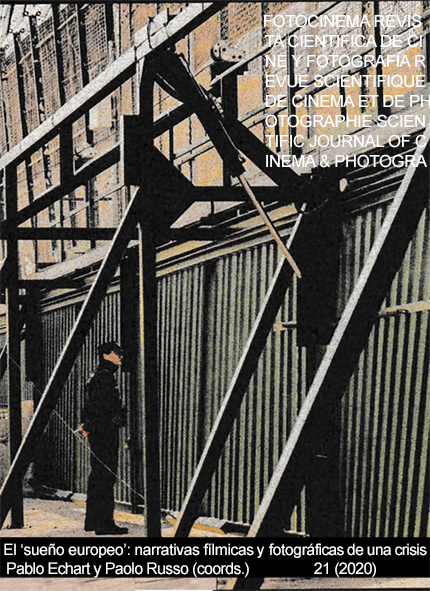The photography in Gustavo Doré’s work during his trip to Spain
DOI:
https://doi.org/10.24310/Fotocinema.2020.vi21.10010Keywords:
Photography, Engraving, Illustration, Drawing, Image and Printing, Photography imagesAbstract
Gustavo Doré is considered one of the great universal illustrators. Throughout his life he made a very extensive work highlighting especially the work done to illustrate the Bible, the Quixote and the Divine Comedy. In 1862 he embarked on a trip through Spain accompanied by hispanist Charles Davillier. One of his objectives was to be inspired to carry out his work on Don Quixote, but as a result of the trip, several deliveries were published for the magazine Le Tour du Monde, between 1862 and 1873 and, finally, a book, entitled L'Espagne, published in 1874. But what is surprising in this work, and has not been well studied so far, is that Doré, whose work was characterized by an overflow-wing imagination, used numerous photographs for the realization of between 15 and 20% of the engravings that illustrated the magazine and the book.
Downloads
Metrics
Publication Facts
Reviewer profiles N/A
Author statements
Indexed in
-
—
- Academic society
- N/A
- Publisher
- Universidad de Málaga
References
Bégin, Émile. (1852). Voyage pittoresque en Espagne et en Portugal. París:Belin-Leprieur et Morizot.
Casado Cimiano, P. (2013). Biografía Gustave Doré (1832-1883). En Doré y las Fábulas de la Fontaine en la Colección UC de Arte Gráfico. Cantabria: Universidad de Cantabria.
Davillier, Ch. (1874). L'Espagne, illustrée de 309 gravures dessinées sur bois par Gustave Doré. París: Librairie Hachette et Cª.
Díaz Francés, M. (2016). J. Laurent 1816-1886, un fotógrafo entre el negocio y el arte. Madrid: Ministerio de Educación, Cultura y Deporte.
Fernández Rivero, J. A. (2004). Tres dimensiones en la historia de la fotografía. La imagen estereoscópica. Málaga: Editorial Miramar.
Fernández Rivero, J. A. (2011). Los fotógrafos Lamy y Andrieu. En Una imagen de España. Fotógrafos estereoscopistas franceses (1856-1867). Madrid: Fundación Mapfre.
Fernández Rivero, J.A. & García Ballesteros, M.T. (2017). Descubriendo a Luis Masson, fotógrafo en la España del XIX. Málaga: Ediciones del Genal.
Fontanella, L. (1999). Clifford en España. Un fotógrafo en la corte de Isabel II. Madrid: El Viso.
Foulché-Delbosc, R. (1896). Bibliographie des voyages en Espagne et Portugal. París: H. Welter.
Hamerton, Ph. G. (1864). Gustave Doré, The Fine Arts Quarterly Review, oct, pp. 4-5.
Jerrold, B. (1891). Life of Gustave Doré. London: W. H. Allen & Co. Ltd.
Kaenel, P. (2012). Gustave Doré à l'ouvre: vision photographique, imitation et originalité. Textimage, octobre, 1-17. https://revue-textimage.com/conferencier/01_image_repetee/kaenel.pdf
Lerebours, N. (1840-1844). Excursions Daguerriennes, représentant les vues et les monuments les plus remarquables du globe. París.
Montes Ruiz, R. (1999). Córdoba en la segunda mitad del siglo XIX, a través de las fotografías de J. Laurent. En La Andalucía del siglo XIX en las fotografías de J. Laurent y Cª. Almería: Junta de Andalucía.
Piñar Samos, J, & Sánchez Gómez, C. (2013). Luz sobre papel. La imagen de Granada y la Alhambra en las fotografías de J. Laurent. 2ª ed. Granada: TF/Patronato de la Alhambra.
Riego, B. (2001). La construcción social de la realidad a través de la fotografía y el grabado informativo en la España del siglo XIX. Santander: Universidad de Cantabria.
Roscoe, T. (1836). The Tourist in Spain. Andalusia. Londres: Robert Jennings & Co.
Sazatornil Ruiz, L. (2011). El Barón Davillier: Hispanista, anticuario y viajero por España. En Cabañas, M. El Arte y el Viaje. Madrid: Instituto de Historia.
Sazatornil Ruiz, L. (2016). El Voyage en Espagne de Gustave Doré y el Barón de Davillier. En El viaje por España de G. Doré en la Colección UC de Arte Gráfico. Santander: Universidad de Cantabria.
Sougez, M. (1985). Historia de la fotografía. Madrid: Cátedra.
Sougez, M. (1989). La imagen fotográfica en el medio impreso. Desarrollo de la fotomecánica y aproximación a los inicios en España. En Kurtz, G. &Ortega, I. 150 años de fotografía en la Biblioteca Nacional. Madrid: Ministerio de Cultura.
Taine, H. A. (1855). Voyage aux eaux des Pyrénées. Paris. L. Hachette et Cie.
Levenfeld, R. [Comisario] (2014). El mundo al revés. El calotipo en España. Pamplona: Museo Universidad de Navarra.
Zola, E. (1892). Mis odios. Madrid: La España Moderna.
Downloads
Published
How to Cite
Issue
Section
License
All contents published in Fotocinema Revista científica de cine y fotografía are protected under the Creative Commons Attribution-NonCommercial-ShareAlike 4.0 International (CC BY-NC-SA 4.0) license. All about this license is available in the following link: <http://creativecommons.org/licenses/by-nc-sa/4.0>
Users can copy, use, redistribute, share and exhibit publicly as long as:
- The original source and authorship of the material are cited (Journal, Publisher and URL of the work).
- It is not used for comercial purposes.
- The existence of the license and its especifications are mentioned.
There are two sets of authors’ rights: moral and property rights. Moral rights are perpetual prerogatives, unrenounceable, not-transferable, unalienable, imprescriptible and inembargable. According to authors’ rights legislation, Fotocinema. Revista científica de cine y fotografía recognizes and respects authors moral rights, as well as the ownership of property rights, which will be transferred to University of Malaga in open access. The property rights are referred to the benefits that are gained by the use or the dissemination of works. Fotocinema. Revista científica de cine y fotografía is published in an open access form and it is exclusively licenced by any means for doing or authorising distribution, dissemination, reproduction, , adaptation, translation or arrangement of works.
Authors are responsable for obtaining the necessary permission to use copyrighted images.














13.png)



